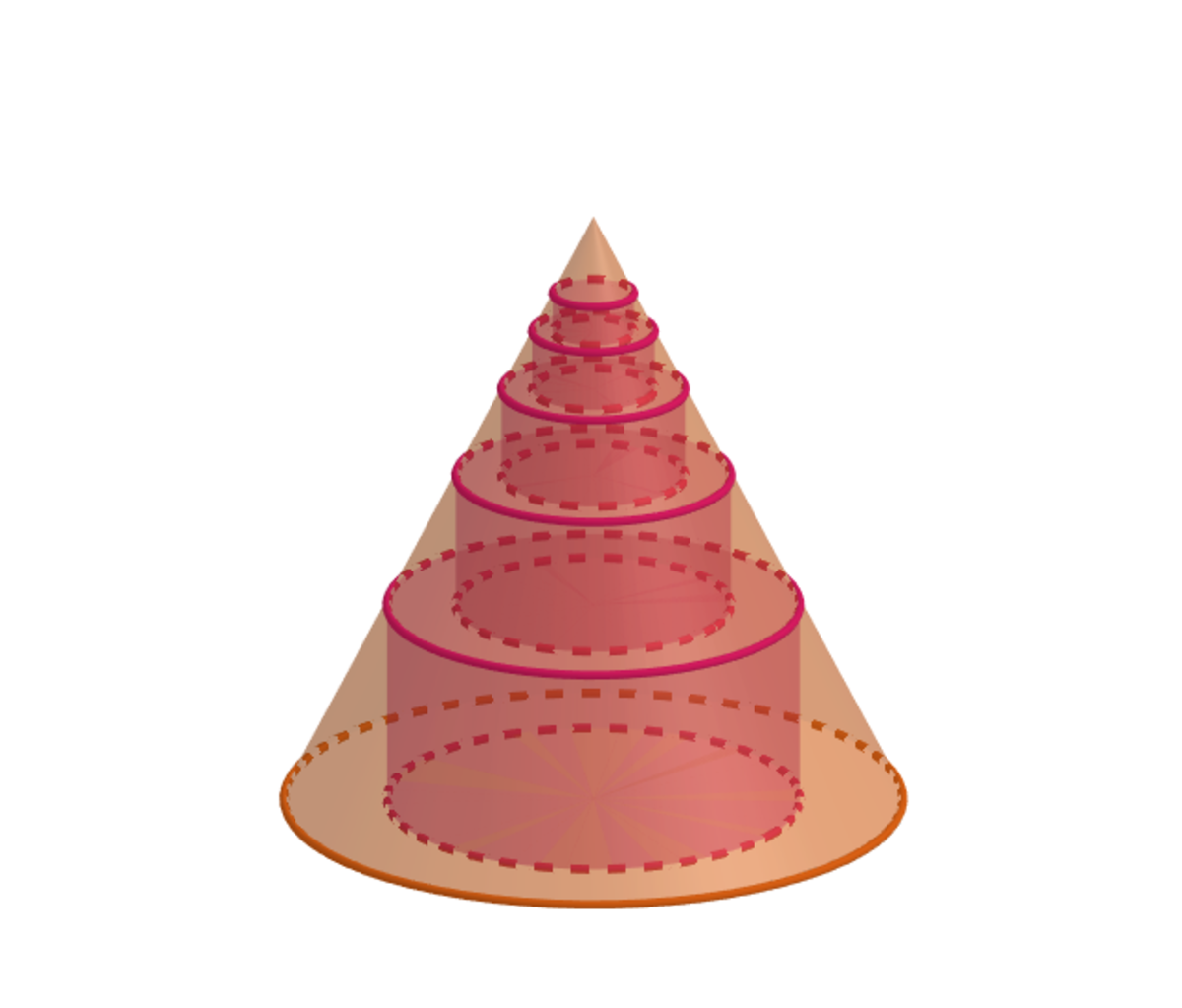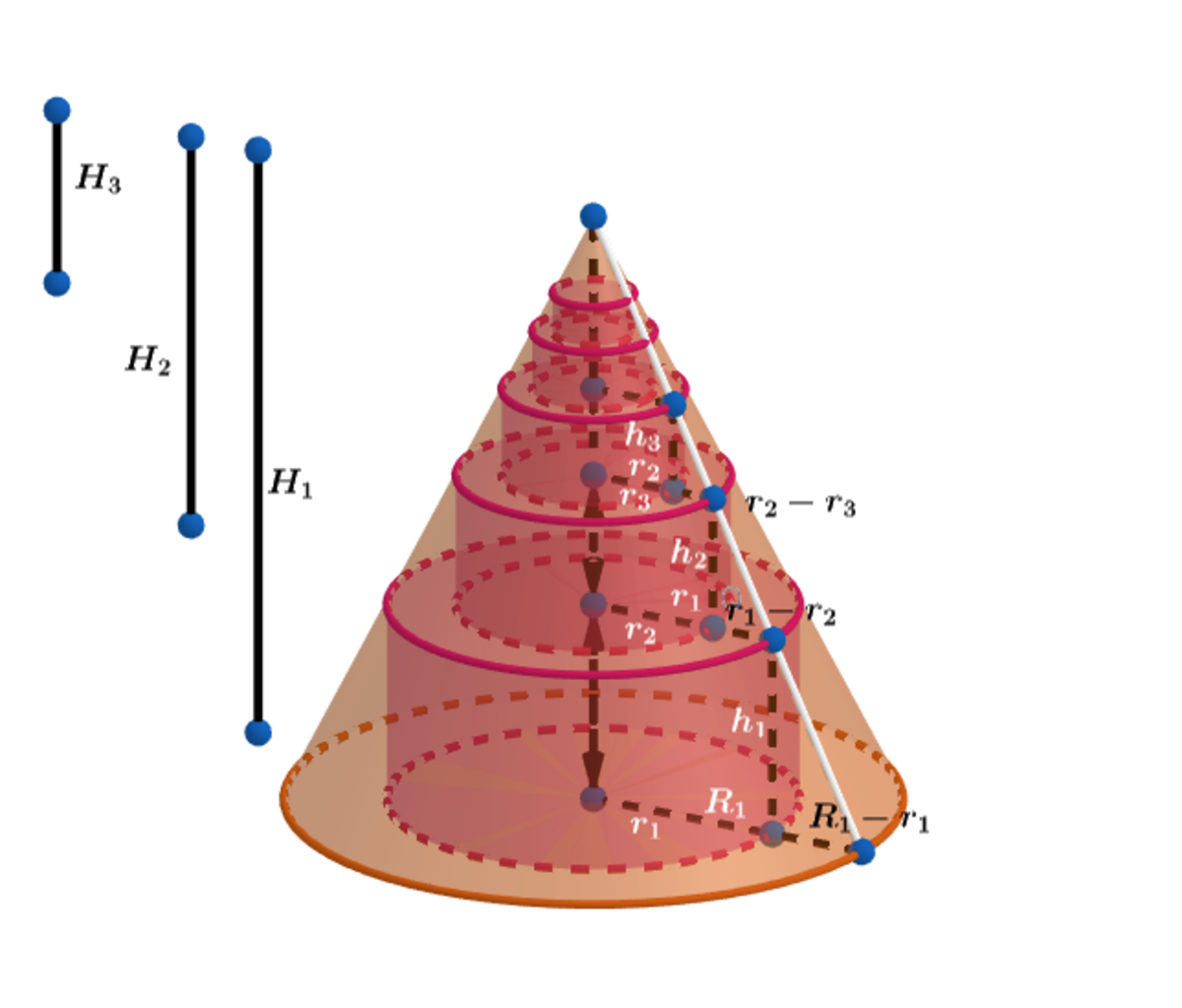Stacked cylinders inscribed in a cone!

Extend the above diagram to an infinite number of stacked right circular cylinders inscribed in the above right circular cone.
Let S represent the total volume of all the cylinders and V c o n e be the volume of the cone.
If V c o n e S = b a , where a and b are coprime positive integers, find a + b .
Note: The initial right circular cylinder is the largest right circular cylinder that is inscribed in the above right circular cone. Each consecutive right circular cylinder is the largest right circular cylinder that can be inscribed in the remaining right circular cone.
The answer is 31.
This section requires Javascript.
You are seeing this because something didn't load right. We suggest you, (a) try
refreshing the page, (b) enabling javascript if it is disabled on your browser and,
finally, (c)
loading the
non-javascript version of this page
. We're sorry about the hassle.
2 solutions

Let R 1 and r 1 be the radius of the cone and the initial cylinder and H 1 and h 1 be the height of the cone and the initial cylinder.
V c o n e = 3 π R 1 2 H 1 and V 1 = π r 1 2 h 1 the volume of the initial cylinder.
From the above diagram we have the proportion:
R 1 − r 1 R 1 = h 1 H 1 ⟹ h 1 = R 1 H 1 ( R 1 − r 1 ) ⟹ V 1 = R 1 π H 1 ( R 1 r 1 2 − r 1 3 ) ⟹
d r 1 d V 1 = R 1 π H 1 ( 2 R 1 − 3 r 1 ) = 0 and r 1 = 0 ⟹ r 1 = 3 2 R 1 ⟹ h 1 = 3 1 H 1
H 2 = H 1 − h 1 = 3 2 H 1 and r 1 − r 2 r 1 = h 2 H 2 ⟹ h 2 = r 1 H 2 ( r 1 − r 2 )
⟹ V 2 = r 1 π H 2 ( r 1 r 2 2 − r 2 3 ) ⟹ d r 2 d V 2 = r 1 π H 2 r 2 ( 2 r 1 − 3 r 2 ) and r 2 = 0 ⟹
r 2 = 3 2 r 1 = ( 3 2 ) 2 R 1 ⟹ h 2 = r 1 H 2 ( 3 2 − 9 4 ) R 1 = r 1 H 2 ( 9 2 ) R 1 = 3 2 H 1 ∗ 2 R 1 3 ( 9 2 ) R 1 = 9 2 H 1 = 3 1 ( 3 2 ) H 1
∴ r 2 = ( 3 2 ) 2 R 1 and h 2 = 3 1 ( 3 2 ) H 1
H 3 = H 2 − h 2 = 9 4 H 1 and r 2 − r 3 r 2 = h 3 H 3 ⟹ h 3 = r 2 H 3 ( r 2 − r 3 ) ⟹
V 3 = r 2 π H 3 ( r 2 r 3 2 − r 3 3 ) ⟹ r 3 d V 3 = r 2 π H 3 r 3 ( 2 r 2 − 3 r 3 ) = 0 and r 3 = 0 ⟹
r 3 = 3 2 r 2 = ( 3 2 ) 3 R 1 ⟹ h 3 = r 2 H 3 ( 9 4 − 2 7 8 ) R 1 = r 2 H 3 ( 2 7 4 ) R 1 =
9 4 H 1 ∗ 4 R 1 9 ∗ 2 7 4 R 1 = 2 7 4 H 1 = 3 1 ( 3 2 ) 2 H 1
∴ r 3 = ( 3 2 ) 3 R 1 and h 3 = 3 1 ( 3 2 ) 2 H 1
In General:
r n = ( 3 2 ) n R 1 and h n = 3 1 ( 3 2 ) n − 1 H 1 ⟹ V n = π r n 2 h n = 3 π ( 3 2 ) 3 n − 1 R 1 2 H 1 =
3 π ( 3 2 ) 3 n ( 2 3 ) R 1 2 H 1 = 2 π ( 2 7 8 ) n R 1 2 H 1
⟹ S = ∑ n = 1 ∞ V n = 2 π R 1 2 H 1 ( 2 7 8 ) ( 1 9 2 7 ) = 1 9 4 π R 1 2 H 1 = 1 9 4 ( 3 1 π R 1 2 H 1 ) 3 =
1 9 1 2 V c o n e ⟹ V c o n e S = 1 9 1 2 = b a ⟹ a + b = 3 1 .
Note: We could have wrote: V n = 2 3 ( 3 2 ) 3 n V c o n e ⟹ S = V c o n e 2 3 ∑ n = 1 ∞ ( 2 7 8 ) n =
2 3 2 7 8 1 9 2 7 V c o n e = 1 9 1 2 V c o n e
Let the base radius and height of the cylinder be r and h and those of the inscribed cylinder be x and y . Then we note that r − x y = r h ⟹ y = h − r h x and the volumn of the cylinder is V = π x 2 y = π x 2 ( h − r h x ) . To find V max , d x d V = π h ( 2 x − r 3 x 2 ) . Equating d x d V = 0 , ⟹ x = 3 2 r , y = 3 1 h , and V max = π ( 3 2 r ) 2 ⋅ 3 h = 9 4 V cone , since V cone = 3 1 π r 2 h .
Let V cone = V 1 and the subsequence volumes of smaller cones be V 2 , V 3 , V 4 , ⋯ . Since y = 3 1 h , then the height of the next smaller similar cone is 3 2 h . Therefore V 1 V 2 = ( 3 2 ) 3 = 2 7 8 . As the patent repeats, we have V n + 1 V n = 2 7 8 .
Then the sum of volumes of all cylinder is:
S ⟹ V cone S = 9 4 V 1 + 9 4 V 2 + 9 4 V 3 + 9 4 V 4 + ⋯ = 9 4 ( V 1 + V 2 + V 3 + V 4 + ⋯ ) = 9 4 V cone ( 1 + 2 7 8 + ( 2 7 8 ) 2 + ( 2 7 8 ) 3 + ⋯ ) = 9 4 ⋅ 1 − 2 7 8 1 = 1 9 1 2
Therefore a + b = 1 2 + 1 9 = 3 1 .